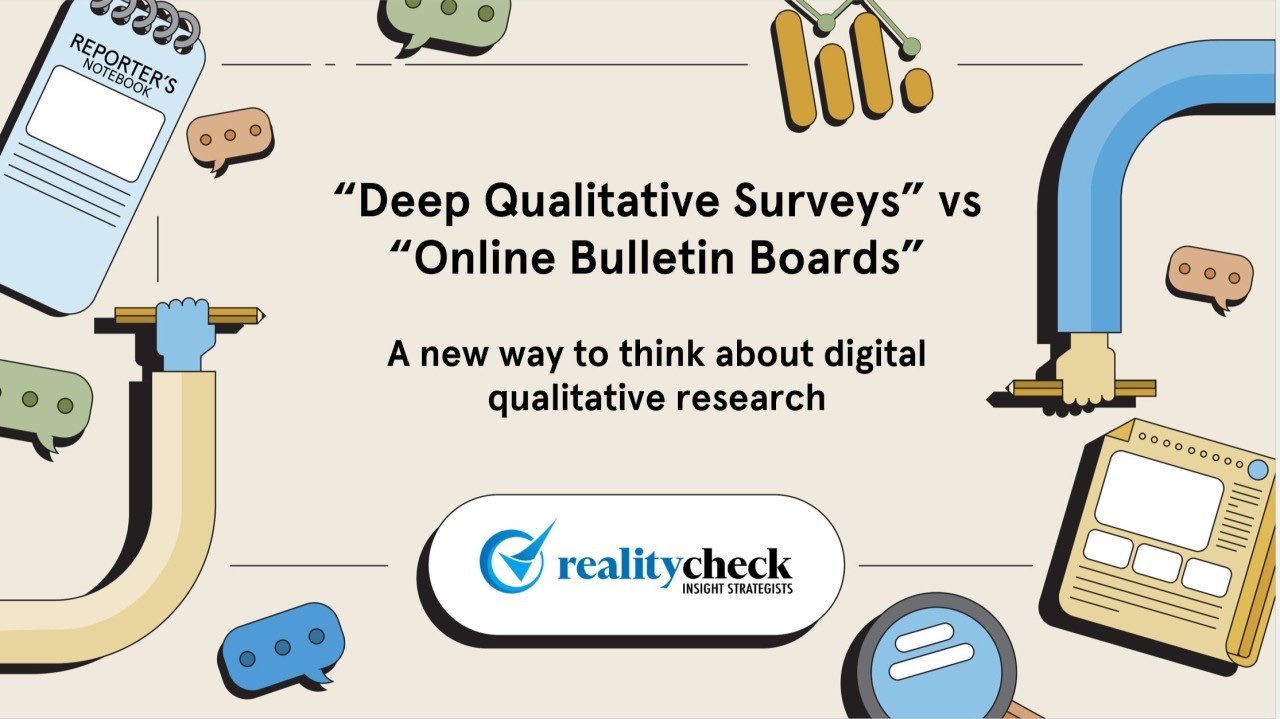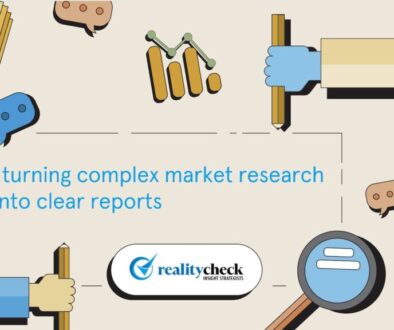Deep Qualitative Surveys vs Online Bulletin Boards: A New Way to Think About Digital Qualitative Research
We recently recommended to a client that she consider an online qualitative study design for an upcoming project, to which she said, “I’m not a big fan of online boards.”
We hear this sometimes when we talk about digital qualitative research.
It seems many in the consumer insights world still refer to all forms of online qual as “Online Bulletin Boards,” ”OBBs” or simply “Boards.”
This is a problem for a few reasons. But overall, the “bulletin board” metaphor limits our thinking about digital qualitative design and analysis. It relegates online qual to an antiquated framework that, frankly, wasn’t all that insightful to begin with.
At RealityCheck Consulting, we believe that a better way to think about online qualitative design and analysis is as a Deep Qualitative Survey rather than a chat or message “board.” I’ll lay out the advantages of Deep Qualitative Surveys vs Online Boards in a minute. But first, a little history.
The Origin of OBBs
The term “Online Bulletin Board” (OBB) originated from the concept of the traditional bulletin board system (BBS), which was popular in the late 1970s and 1980s. That’s a long time ago! A BBS was an early form of online community where users could post messages, share files, and engage in discussions on a variety of topics. The terminology harkens back to the days of dial-up modems. These platforms were among the first to facilitate online communication between users.
As the internet evolved, the term “bulletin board” was adapted to describe similar online forums or message boards where people could post and reply to messages in a threaded format. In market research, the concept was further developed into the “Online Bulletin Board” (OBB), where respondents participated in moderated discussions over several days or weeks.
My problem with the Bulletin Board metaphor still hanging on is what it implies about online qualitative design, methods and analysis. It simply no longer fits the advancements we’ve made over decades of online research.
The problem with OBBs
The reason why many have negative perceptions of “boards” is because – as a research method – they are inherently problematic. (Not to mention antiquated, as I hope the history lesson above makes clear.) In OBBs, respondents interact in a group setting, often leading to groupthink and bias. Participants may influence each other’s responses, consciously or unconsciously, which can skew the data and reduce the authenticity of individual insights.
Moreover, the individual, respondent-level data collected from OBBs is interwoven, making it challenging or even impossible to disentangle the responses of individual participants. This interconnectedness complicates any effort to conduct rigorous text analytics, coding, or statistical analysis, limiting the depth and reliability of the insights.
Enter Deep Qualitative Surveys
At RealityCheck, we design and analyze online qualitative studies more like a Deep Qualitative Survey than a chat or message board. The combination of smart, creative study design and current technology makes this possible.
I think the survey metaphor works much better than the “board” metaphor because of a few key characteristics.
- First, in a Qualitative Survey, data are collected individually rather than in a chat/group setting.
- Second, current asynchronous platforms allow us to design studies using a huge range of creative and projective questions, tasks and exercises that you simply can’t do in a forum setting.
- Third, advancements in AI text analytics, coding and statistical analysis make analyzing the unstructured data we get from Qualitative Surveys deeper and more efficient.
A bit more about each of these advantages:
- Individualized Responses: Unlike OBBs, Deep Qualitative Surveys are asynchronous and individual, meaning respondents answer questions on their own time (usually within a certain time frame) and individually rather than as part of a group. To put this into formal study design terminology, the unit of analysis or case is the individual respondent. In a chat or board, the unit of analysis is, well, the chat or board.
The real benefit of this approach is that it eliminates the groupthink and bias that can plague group settings, ensuring that each participant’s voice is heard clearly and without outside influence. Asynchronous qualitative platforms create individual records of respondent data – like a survey – but still with qualitative depth and richness. (This, by the way, is also an advantage asynchronous digital qual over in-person focus groups!)
- Creative and Projective Exercises: Deep Qualitative Surveys combine closed- and open-ended questions with projective techniques such as image selection, collage building, storytelling, and video/photo uploads. This variety of stimuli and response formats allows us to capture the depth and nuance of respondents’ thoughts and emotions.
To add another layer of insight, our Deep Qualitative Surveys can include both moderated and unmoderated webcam interviews. These interviews provide context and additional depth.
At RealityCheck, we take a lot of cool techniques developed in the fields of psychology and anthropology and apply them to our digital qual designs. The possibilities for deep exploration are endless, whereas in a chat/board setting, your options are much more limited.
- Data are ready for advanced analysis: Because data are collected on an individual basis, similar to quantitative research, we can apply text analytics, coding, and statistical analysis with greater precision and reliability. Frequencies of themes in video and text, aggregation of key concepts across groups, and even multivariate statistical analysis are possible.
We’ve found that the combination of comprehensive statistical analysis and deeply textured verbatims and video content create amazing insights stories that give clients inspiration but also the confidence in the data to make decisions and act.
Qualitative at Scale
One final advantage of approaching digital qual as a Deep Qualitative Survey rather than a board is it opens up your thinking to qualitative at scale.
Thanks to advancements in text analytics and AI analysis capabilities, this method is not only effective for traditional qualitative sample sizes but also allows for rich, deeply textured qualitative analysis with hundreds of respondents in a single study. This scalability ensures that even large-scale research projects can maintain the same level of depth and rigor as smaller studies.
So I think it’s time for a mind-shift in qualitative research. It’s time for us to stop thinking in terms of “OBBs” and start thinking in terms of Deep Qualitative Surveys that leverage all of the creativity and deep analysis qual is known for and the technology advances in data collection and analysis that are now at our fingertips.
As always, we’d love to know what you think. Where does the idea of a Deep Qualitative Survey take you? Is that the right way to refer to the new age of digital qualitative research? How do you think of and refer to the world of online qual these days?
























